“Don’t believe what your eyes are telling you. All they show is limitation. Look with your understanding. Find out what you already know and you will see the way to fly.” [Richard Bach, Jonathan Livingston Seagull]
![To most people, the Sky is the limit. To those who love aviation, the Sky is HOME. [Jerry Crawford]](http://foodforthought.barthel.eu/wp-content/uploads/2020/03/Crawford-Jerry-The-Sky-is-Home.jpg)
by Jürgen Barthel
![To most people, the Sky is the limit. To those who love aviation, the Sky is HOME. [Jerry Crawford]](https://foodforthought.barthel.eu/wp-content/uploads/2020/03/Crawford-Jerry-The-Sky-is-Home.jpg)
“Don’t believe what your eyes are telling you. All they show is limitation. Look with your understanding. Find out what you already know and you will see the way to fly.” [Richard Bach, Jonathan Livingston Seagull]
![To most people, the Sky is the limit. To those who love aviation, the Sky is HOME. [Jerry Crawford]](http://foodforthought.barthel.eu/wp-content/uploads/2020/03/Crawford-Jerry-The-Sky-is-Home.jpg)

The posts since 06. March focused on the Corona crisis have been moved to the static pages (see menu on the right)
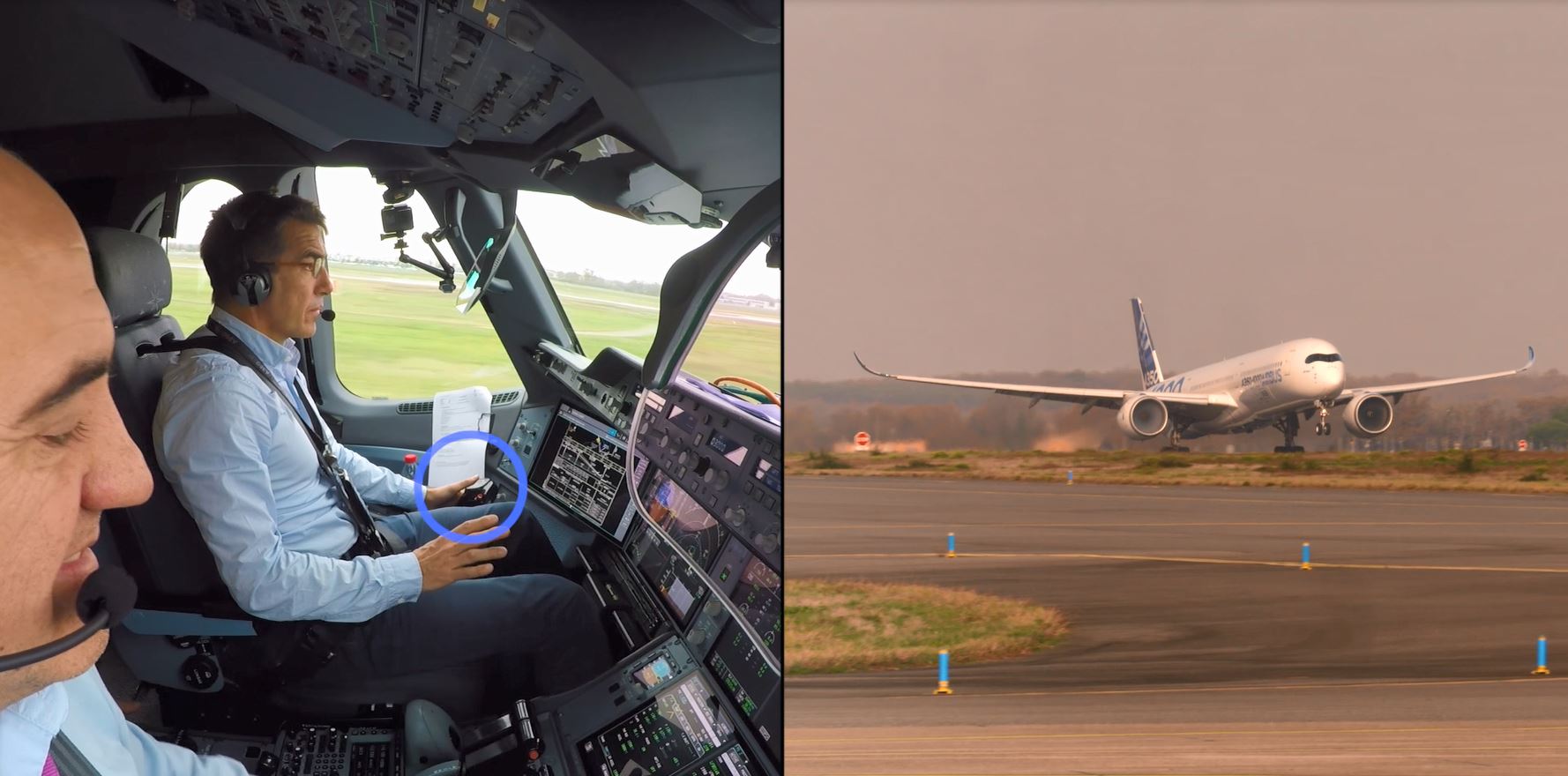

B737max, Air France 447, Asiana 214 – and computer failures reason for the largest flight cancellations in the past two years. Lesson (to be) learned…?
Following a discussion triggered by Airbus’ automated take-off last week, I posted a comment on LinkedIn:
“Just discussed the issue of “autonomous flying”, two examples against it. Asiana flight 214 (there was also a similar incident with Turkish Airlines) caused by a pilot with a semi-religious belief in the Auto-Pilot. Said to have very little experience “flying manual”. And the 737MAX, also to keep in mind the missing redundancy of sensors to safe cost. Also Air France 447 accounted to incorrect sensor readings. One reason I don’t see a “pilot free cockpit”, but a “cockpit flight manager”. Like the flight attendants there in case of need, but usually just monitoring proper systems. “Accompanied” by a drone-operator at the AOC. Having GBAS+GPS a system to constantly monitor the four-dimensional position of the aircraft and if in line with flight plan. If not, maybe a sensor-glitch misguiding the aircraft? Please “Pilot” or “drone operator” override the faulty sensor…”
Several replies, notably the one public response by David Eiser outline the threat: “Too much reliance on automation by both operators and pilots is one of the biggest threats today.”
A frequent issue I discuss when discussing AOC or APOC (airline or airport operations centers) is the necessity to have fallback procedures in case of IT failure! This is also in line with disruption management and the fact that the major disruptions of the past two years were caused not by weather, but IT failures! Just an example reported by Wall Street Journal.
Back in 1990, I came as a Sales person to the Frankfurt Airport to meet and greet an important FAM-group – FAMiliarization – a group of journalists invited for a trip overseas. To learn the flight would not take off, as the airport check-in-system failed. I got a printed passenger list, a stack of boarding passes and after 10 minutes of preparations issued the boarding passes to the passenger. With only 75 minutes into the process the flight got readied for departure. It was as far as I remember, the only flight that left that day during the computer downtime. Lufthansa used a different system, their flights were not impacted.
That was my day to learn the lesson to have fallback procedures in case of a computer glitch. It was driven home over the years by other failures that became public. But more and more, I also learned that managers developed a semi-religious faith in computer systems. Redundant systems cover for a failure, right? Wrong. Working with AOCs and APOCs – there are no system redundancies. If a system fails, there is a downtime. Period.
 Computer Literacy
Computer LiteracyAs Richard Maslen just wrote on CAPA’s Blue Swan Daily: “It used to all be about passes in English and Mathematics, now it is blockchain, cloud computing and analytical reasoning – the changing mix of skills most prized by the business world”. It is another example of the semi-religious faith in IT I talk about. Big Data was the buzzword everyone talked about and nobody had a clue on what it really meant. It’s hip, so it must be good. Now we added blockchain, cloud computing and analytical reasoning. Important buzzwords, but if you look for a business case, it’s for the ones making themselves a business with it.
 Cloud Computing
Cloud ComputingDid you know that aviation was the first large application of cloud computing? Sabre enabled to book flights from anywhere in the world anywhere in the world. I used Sabre-messages back in 1987 – that was years before e-Mail. Tell me about Cloud Computing. On the backside, most recent computer failures forcing airline downtimes were caused by small cloud solutions failing and taking down the airlines’ IT system as a collateral damage. Leaving airplanes grounded, passengers stranded.
Where aviation has a strong requirement to keep a “history” of changes in their IT systems, blockchain might help, but it adds complexity and slows down systems. And keeps the question of the ultimate truth. If there is a data discrepancy between two independent systems, which ones is the right one? That’s not just on A-CDM between different stakeholders, I’ve seen the same problem arise on internal systems aplenty!
Now on analytical reasoning, it goes with the old issue of who analyses with what intent. As the old saying goes, I only trust the statistics I falsified myself.
 Aircraft System Redundancy
Aircraft System RedundancyNow have we learned our lessons? Speaking to academically educated managers, I find a lot of superficial knowledge. Like the Big Data picture. Someone – usually the IT companies – come up with those buzz words and explain they are important. They are not unimportant. But it boils down to my usual question: Give me a business case. No wishful thinking. Nor divine revelation and forget what the stars foretell!
Boeing managers, in what I consider a criminal neglect, prioritized commerce over safety. In line with FAA and others. “Shareholder Value” is a word that was invented in the U.S. It implies that the only value a shareholder has is short-term profit. I disagree ever since I learned the word back in 1997 in the process of the IPO of Cytric. At the time my baby – yes, the one today owned by Amadeus. Shareholders have different values. Long term profitability. Sustainability, not even linked to profitability. An idea. Something “good”.
Now Boeing used a single sensor to trigger MCAS. And the system overruled the pilots. It crashed two airplanes. The cause? Greed. A mortal sin.
 Faith in The Computer
Faith in The ComputerA key-finding on Asiana 214 was a pilot who believed in his on-board computers. Who had thousands of “auto-pilot” hours, but very little experience in manual flying. Who did not grasp that for a wrong sensor his system was wrong. Who made small mistakes on his computers’ settings (i.e. direct input, no landing flaps) ignored the tower’s advise to do a turn-around, to disrupt the landing and start the landing process anew. A similar case grounded a Turkish Airline plane. Pilots like this make a case for autonomous flying. Better a stupid computer than a pilot with blinders.
Another sensor failure caused the crash of Air France 447. GPS giving a three-dimensional point in space, where are the systems that provide that information to the pilots at night? How can it be that pilots and airplanes loose their direction in the air?
And while we talk about GPS and GBAS in aviation, a flight like MH 370 teaches the same lesson. Not the one shot down over Ukraine, but the one that got lost over the Indian Ocean. Airline and authorities are blind over the big oceans. All those fancy systems, satellites, etc. and we have no information, neither in the cockpit nor at the control centers, where the flights are? And trust in pilots following navigational directions (semi-)blind?
A frequent argument for the cockpit automation is German Wings flight 9525, where the pilot flew the airplane into the mountain. While that was a freak incident, neither pilot nor computers are “fail-safe”. All we can do is to minimize the risk. And while autonomous flying will come, I’m an advocate for a “flight operator”, both in the cockpit, as well as on the ground. Then we have three independent “systems” and any two will override the third. Still, there will be ad hoc decisions to be taken, then who “rules”? If you have another aircraft on collision course. If you have foreign object or another aircraft on the runway.
 Fly by Wire, Drones and Air Taxis
Fly by Wire, Drones and Air TaxisSince the development of Fly-by-Wire, airplanes cannot fly without computer aid. If the computer fails, the steering signals from the side stick go nowhere. So we already rely on the computers in airplanes. And a computer failure will result in a crash. Period. But Fly-by-Wire also makes the case for automated flying.
Pilot-less air taxis already require a fully automated system. If you consider them to fly in airport vicinity, they interact with the flight plans of commercial airplanes, today considered a major security risk with an excessive bureaucracy for a single approval for any plane, helicopter or drone entering the airport’s air space!
 A similar case is the automated drones as envisioned by Amazon, DHL and others, for automatic passenger delivery. As the air taxis, they will rely on a fully-automated flight planning and flight plan filing with the authorities’ computers. Simply to avoid in-air-collisions.
A similar case is the automated drones as envisioned by Amazon, DHL and others, for automatic passenger delivery. As the air taxis, they will rely on a fully-automated flight planning and flight plan filing with the authorities’ computers. Simply to avoid in-air-collisions.
While commerical airplanes, delivery drones and air taxis follow pre-assigned flight plans and routes, drones are operator-guided… Can we expect manually guided drones in the air space of other operators? Be it air taxis, helicopters or airplanes? I doubt it, I believe this is a short-lived fashion. Soon drones will be so restricted in use that they go back to hobby and in pre-assigned areas. All other operations requiring the filing of a flight plan!
I like the examples in The Fifth Element. Or Doctor Who’s episode Gridlock (image). We’re not talking about individual travel or we risk air accidents, way more potent than any car accident you might imagine today! This can only work in a fully automated environment. You want to change your flight plan? The computers must secure a safe route in four-dimensional space – including the time, beyond what ATC can do today! A constant prediction of traffic for several hours ahead!
I take it with Heinlein, as he wrote in Friday, a 1982 novel. I believe we will have ability for a fully automated flight, which will also improve A-CDM and flight planning. We will have a pilot on board. Plus a drone-pilot in the AOC. Heinlein wrote that the pilot no longer pilots but is there for the sake of passengers’ reassurance. The pilot unlikely to have better ideas than the computer.
The pilots will be turned into a flight operator in the cockpit, plus a flight operator on the ground. Both will be specialists, but I predict that their “work times” will no longer be privileged, but more like computer specialist. Automated flight management will reduce the work load and make those jobs mostly observational. Making privileges in duty times or salaries obsolete. Heresy. To the pilot industry. But in my opinion a “logical consequence” since the introduction of fly-by-wire – which also was the start of the discussion about autonomous flying.
Side note: This will also automate Air Traffic Control, ground handling, etc., etc. – Give take 100 years, likely less, we will have air traffic automated. With very limited manual input by pilots or other stakeholders. Backbone is slot management, scheduled flight planning. Then add “scheduled air-taxi” (air-bus), followed by delivery drones (for people or freight), ad-hoc flights. Think about medical emergency but also “VIP” flights (Air Force One)…
Food for Thought!
Comments welcome

This article has originally been published on my LinkedIn page (moved 2020-02-11)

“2020 will unlikely be able to keep up with 2019. But more speaks for shares than the lack of alternatives”
I’m kind of p***ed off by that statement by German DWS’ CIO and his conservative, visionless analysis headline. It reflects exceptionally well on German investors and asset managers (yes, I also talk about those banks) believing in risk-free, high-return investments. ECB frequently accused German banks to not understand the reason for their negative interest: To make deposits at ECB unattractive and force the banks to invest into companies, ideas, visions. Instead to such do their own job and a proper due diligence on good ideas, they focus to co-invest after others did the job, on “established models”, investing into aircraft available in surplus (A320/B737). Or in shares, as there would be no alternatives. Yes, if you have blinders on, you might be right.
Bold investments? Investing into sound ideas and business concepts developed by seasoned managers? Not in Germany. Nor much in Europe. Invest in shares, for the lack of alternatives? Or for the lack of vision? Blinders.

It’s our experience seeking funding for Kolibri.aero. A disruptive aviation business concept. Different. It’s called “USP”. It’s not “me too”. If you know investors that are open to vision, change and “something new”, please refer them to the Kolibris. Or me.
Published by
| Jürgen Barthel Think Outside the Box |
8 Articles |
German DWS (asset management) says shares are must buy because they lack an alternative. How wrong can you be? European Central Bank gives negative interest to promote investment into entrepreneurship. German banks park the largest amount in ECB instead of reinvesting.
#whatsyourusp #thinkoutsidethebox #cognitivedissonanceresolution #investinchange #investmentstrategy #riskmanagement
![“For those who agree or disagree, it is the exchange of ideas that broadens all of our knowledge” [Richard Eastman]](https://foodforthought.barthel.eu/wp-content/uploads/2016/08/eastman_quote.jpg)
![Richard Eastman “For those who agree or disagree, it is the exchange of ideas that broadens all of our knowledge” [Richard Eastman]](http://foodforthought.barthel.eu/wp-content/uploads/2016/08/eastman_quote.jpg)
 … or the question of leeching.
… or the question of leeching.
Social networks become more and more inactive, “leechers” that consume but not share their own opinion even with a “like”. In “online booking”, we called that a “look to book ratio”. In Germany, we call it the “caller in the forest” (echos, but no replies). In modern times it’s called the “social media bubble”. Which statistics say consist of 100:1 or worse “data corpses”.
But this is about success eating its children. The larger your network, the more information jumps up on the timeline. With little to no “filtering”, much of those “news” showing on the timeline becomes “irrelevant”. The more often you post, the more the social networks show your news on your followers timeline. Whereas I would like to be attracted every time someone posts who does not post that often. But then we come to Post Expiration and Information Flooding:
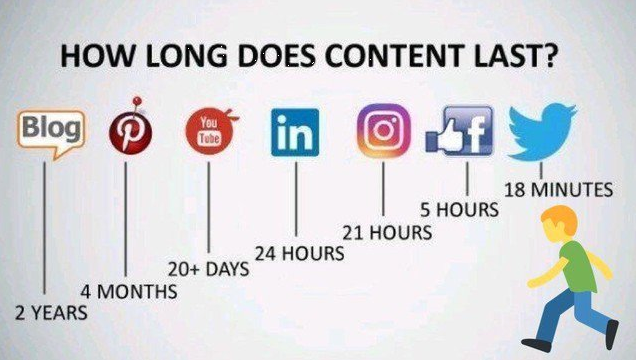
In my last years qualification on “online marketing”, there were some interesting statistics about post visibility, that I found quite interesting.
What is not covered here are the increasingly used online chat tools like WhatsApp, Skype, etc. – posts there are lasting minutes.
You may remember my articles sharing my experience with LinkedIn articles and also media campaigns. As a result, already four years ago, I discontinued writing “articles” on LinkedIn, but with ongoing visits to my blog archive articles, LinkedIn articles (different from the normal posts) have a life span of about three days – older articles are not having relevant visitor numbers ever after.
Now companies, SEO-experts etc. tell you to post constantly to show constantly on those “channels”. But that turns, no it backfires into
 For which there are two reasons. And both reasons are in reality counterproductive.
For which there are two reasons. And both reasons are in reality counterproductive.
In the beginning, Facebook promoted to post “everything”. Other companies built on that and developed i.e. restaurant reviews and posting of food, selfies from the weirdest places on Earth, etc. – now people post all relevant and irrelevant stuff and clog the timelines. Where it was nice in the beginning to get input from friends, now the flood of irrelevant information makes the tools largely unusable. A business friend recently asked me why I did not respond to his latest posts. Well, I was busy with real life and did not even see those posts, they were long gone when I logged in again. Don’t get me wrong, I did the same mistake. Posted irrelevant things, missing out on relevant news.
Now I will intentionally limit my Facebook to less but higher quality posts. So this week I deleted my all the old content (since 2008) of my Facebook profile. I decided to keep my profile but only for an occasional look, the most important “updates” and use of the messenger to reach out to my friends. But it took me three days to remove all that data, even using Chrome Apps that allow bulk cleaning – with some bugs to slow you down anyway. Now I can “restart” with focus on quality, not quantity.
Back in 2016, I removed my “articles” from LinkedIn, after I found them to be seen just a few days with little interaction, whereas this blog, with the same little interaction except from the same people, has several thousand readers meanwhile and a constant flow of readers on the “old” articles as well. Except for a few readers they do not interact, not even with the easy “like” button I’ve added to all posts some years ago. It keeps motivating to hear on conferences that people obviously follow my blog, referring to my articles.

I also last year discontinued to actively use Skype and drop WeChat. Same reason. In business and with friends I now mostly use Viber, WhatsApp (another Facebook-company). Many years ago, I decided to stick my newsletters to ten. As I can’t keep following the flood of information, it distracts from doing business and make money to sustain my family.
A friend on a conference talked about the “first screen” on the mobile phones. While they become bigger, you also need to decide, which apps make it to your first screen. My new smart phone has space for 30 app icons. I may be unusual by having my apps grouped and using folders, even on first screen, but yes, I have my few important ones.
In the expensive Social Media lectures I attended last spring, on which I shared my lessons learned, I mainly learned that if you are a good marketeer, the same rules apply on- and offline. It also confirmed, I can spend all the time someone wants to pay me for, to analyse the online performance with KPIs that are the same useless as the QSI (Quality Service Indicator) as they are set and defined by the analyst with an intentional or (rarely) unintentional outcome in mind: “you are going to get very quickly to ‘factors’ and ‘coefficients’. And that they are variables, subject to interpretation and weighting, they are “relative values” (from The Bias of Route Viability Analysis, Dec. 17).
![Lunchmoney Lewis - I've Got Bills [Unhyping Online Marketing] Lunchmoney Lewis - I've Got Bills [Unhyping Online Marketing]](https://i.ytimg.com/vi/ETM8rrqrTW8/hqdefault.jpg) We all know of headlines that celebrities (and companies) bought and buy “followers”. Implying that all those leechers make an impact to your business. While it may take longer to grow your real “Stammkunden” (patrons, regular customers), only the ones that “buy” or stimulate a purchase by recommendation are valuable to your business. In the end it you got to pay your bills!
We all know of headlines that celebrities (and companies) bought and buy “followers”. Implying that all those leechers make an impact to your business. While it may take longer to grow your real “Stammkunden” (patrons, regular customers), only the ones that “buy” or stimulate a purchase by recommendation are valuable to your business. In the end it you got to pay your bills!
Marketing is about reputation management, it’s about indirect sales, but in the end, marketing is a part of sales and sales support. Brand is marketing, but in the end it is to stimulate memory and reputation and bring the brand to mind in the purchasing process. Neither marketing, nor brand, nor sales or public relations are an end to themselves. They are to stimulate business and keep the coin rolling.
So where do “Social Networks” fit in here? Same issue. Commercially, it does not help to have leechers. You need either buyers, or ambassadors. That must be first and foremost on your activities. Privately, you neither want leechers, you want people that share information with you, to discuss, agree or disagree, help you to evolve.
So I split my activities to two layers. Connecting with friends. While I appreciate a lot of Facebook “friends”, interaction is limited to very few. I will keep posting occasionally there, but just personal and limited to friends and only the “important” news, not to “flood” my friend’s timelines! I use LinkedIn for business and have some other responses there, confirming the value of the network. Xing is a German social network, but I keep finding them focused on job opportunities. So don’t expect me to do much there.
![Snow Patrol - Calling in the Dark We are Listening ... and we're not Blind! This is your Life. This is your Time [Snow Patrol - Calling in the Dark]](http://foodforthought.barthel.eu/wp-content/uploads/2020/01/CallingintheDark.jpg) Instagram? Twitter? YouTube? Tik Tok? Yes I could do more there. If you convince me to drop LinkedIn for better impact to my information exchange with friends…?
Instagram? Twitter? YouTube? Tik Tok? Yes I could do more there. If you convince me to drop LinkedIn for better impact to my information exchange with friends…?
And if you want my opionion, feel free to reach out to me or to share. I’ll keep watching my Facebook timeline for updates and on occasion also look at Instagram. You can reach me directly using Viber or WhatsApp (if you have my number).
And again, it boils down to my early mentor Richard Eastman‘s favorite quote:
“For those who agree or disagree, it is the exchange of ideas that broadens all of our knowledge”
It is all about interaction, about exchange. Without a “feeback loop”, writing blogs or posting on Social Media becomes boring – in turn, more shares turn to leechers – and the slow dying of Social Media continues. And if you like this post, click onto the little like button… If you did not, let me know what I could do better or where I’m far off in your opinion. Preferably not by e-Mail or direct message, but use the comments function this blog has.
Food for Thought
Comments welcome!

Recently, I attended the ISHKA conference Investing in Aviation Finance: Germany in Munich where one session addressed Why are airline bankruptcies still happening in a booming environment?
There are some, very few, very common reasons. And auditing airline business plans, start-ups and established, I keep raising the same questions.
 Back in the 90’s, I became the honorary member of the Airline Sales Representatives Association in Frankfurt. Aside the narrow-minded thinking of sales managers denying to understand that the emerging Internet was about sales channels, it kept and keeps bugging me, that they focused on their “sales channels”, denying responsibility for the new channels, as they had to be handled “by others”. In the beginning and to date, many if not most airlines have no personal e-Mail-contacts for their customers, be it travelers, travel agencies or online portals. The same applies to their smartphone numbers.
Back in the 90’s, I became the honorary member of the Airline Sales Representatives Association in Frankfurt. Aside the narrow-minded thinking of sales managers denying to understand that the emerging Internet was about sales channels, it kept and keeps bugging me, that they focused on their “sales channels”, denying responsibility for the new channels, as they had to be handled “by others”. In the beginning and to date, many if not most airlines have no personal e-Mail-contacts for their customers, be it travelers, travel agencies or online portals. The same applies to their smartphone numbers.
My former boss Louis Arnitz used a historic lesson to explain the change we faced converting FAO Travel, a “classic” business travel agency into i:FAO, the first European business travel portal. In the 19th century, rail companies built the railroads of America. Replacing the Pony Express. Then came those crazy flyers, “aviators”, in their small machines transporting mail. To date rail and air travel are not “connected” (very few exceptions). Because the managers understood the building of steel railroads as their business. Not the transport of people. And they still focus on the wrong priorities. Airline and Rail managers alike.
11 years ago, I wrote about the revival of the sales manager.
 Speaking about Sales Managers ignorance to the cost of their airline’s operation, I found the fish stinks from the head first being a true proverb. I’ve met too many investors, airline managers, airport managers, not understanding the cost involved. Then they try to compete on the price with the large, established airlines. I have no idea, what those managers learned, I heavily doubt the quality of university education…
Speaking about Sales Managers ignorance to the cost of their airline’s operation, I found the fish stinks from the head first being a true proverb. I’ve met too many investors, airline managers, airport managers, not understanding the cost involved. Then they try to compete on the price with the large, established airlines. I have no idea, what those managers learned, I heavily doubt the quality of university education…
The recent failure of Ernest is a “classic”. They take little money, rent Boeing 737 or Airbus A320 family airplanes, in case of Ernest 1 A319 and 3 A320. Then they buy software licenses (COTS, Commercial Off The Shelf). They buy ground handling and maintenance. Something I learned studying Whole Sale & Foreign Economics 35 years ago: If you outsource, it is either more expensive or you they safe from the service levels they provide.
Something I keep telling about consulting. If you need someone with special knowledge for a short time, you “outsource”, you hire a consultant to do the job. If you need something long-term, you hire a consultant to develop the know-how within your company. Again, the job for the consultant is short term.
In both cases you pay for the experience.
Airline managers that do not understand their real CASK, their Cost per Available Seat Kilometer (or mile as CASM), are not doing their job! Airline managers that fire good people because they are “too expensive”, airline managers that save on “service”, don’t understand reputation and brand as important are being doomed from the outset.
So these airline startups come and believe that with some 10 million Euro, leasing the same (but usually older) aircraft, pay for outsourced maintenance, IT, ground handling, etc., etc. They truly believe they can “succeed” in the shark pond where an easyJet owns 70-80% of their fleet. Only some 20-25% being still paid off (until they own them), less than 3% being leased to cover for ad hoc demand. Where they run their own maintenance operation, their own ground handlers where they can. Then they have established processes and understanding of the cost of disruptions and delays – and cover them with an own fleet of spare aircraft. Do those small airline operators have any spare aircraft on hand when their aircraft fails them?
 From Cobalt, Germany, Primera (alphabetical order), feedback said “disruption cost”, attributed i.e. to EU261 “passenger rights” to having been a major reason for their financial troubles. Still, most business plans, I was asked to have a look at last year failed to address that issue at all. Or they used “easyJet figures”, neglecting the fact that easyJet has a spare fleet to cover and minimize the effects of flight disruptions.
From Cobalt, Germany, Primera (alphabetical order), feedback said “disruption cost”, attributed i.e. to EU261 “passenger rights” to having been a major reason for their financial troubles. Still, most business plans, I was asked to have a look at last year failed to address that issue at all. Or they used “easyJet figures”, neglecting the fact that easyJet has a spare fleet to cover and minimize the effects of flight disruptions.
Even large airlines’ network managers keep ignoring those cost factors and then get surprised when a route fails. Others go to considerable lengths to understand the typical delays they incur on specific routes. Caused by the ground handler, the departure and/or arrival airport, taxi times, the air traffic control – or simply common weather issues like fog in Stuttgart.
So taking all those common and neglected factors into account: What’s your cost? CASK is one value for the entire company – do you understand the performance on the specific route or airport? Why is it often the same airports “failing”? Maybe they shouldn’t be overly optimistic but be more realistic? And yes, that is the same airports believing if they reduce the landing fee, it would have some decision making impact on the airlines’ cost. It’s that level of non-understanding that causes constant and ongoing failures – not just for newcomers or small airlines.
Shortly prior their demise, a board member of Cobalt answered my question about their USP: “We’re Cypriot.”
Say what? Competing against easyJet and other low cost and classic network carriers, that is all there is for a USP?
His second answer about USP was “We’re cheaper.”
Okay. You operate 2 A319 and 4 A320. easyJet operates what, more than 330 A320 family aircraft. You think you’re “cheaper”? Really?
Another airline answered my same standard question with: We fly different routes.
Well… Hard to not be nasty. They just wonder that on their most successful routes, the other, bigger carriers kick their butts and take over those routes.
 Carolin McCall understood “service” to be a difference maker. Since her leave, very quickly they dropped from my “role model” and preferred airline to “me too”. Taking over aircraft from Air Berlin with additional and “bulkier” seats, I suddenly experienced less leg space. Their airport manager at one of their hubs found himself quickly “obsolete”, the new paradigm being “cost savings”. In turn they seized my (half-sized) cabin bag due to “full overheads”. Aside the seat next to me being empty, there was more than enough space below the seat. Heard meanwhile from many frequent flyers they no longer wait if they have an aisle seat but make sure they have their seat and the cabin baggage with them. Would be indeed interesting to have some statistics how that impacts boarding time.
Carolin McCall understood “service” to be a difference maker. Since her leave, very quickly they dropped from my “role model” and preferred airline to “me too”. Taking over aircraft from Air Berlin with additional and “bulkier” seats, I suddenly experienced less leg space. Their airport manager at one of their hubs found himself quickly “obsolete”, the new paradigm being “cost savings”. In turn they seized my (half-sized) cabin bag due to “full overheads”. Aside the seat next to me being empty, there was more than enough space below the seat. Heard meanwhile from many frequent flyers they no longer wait if they have an aisle seat but make sure they have their seat and the cabin baggage with them. Would be indeed interesting to have some statistics how that impacts boarding time.
So what’s your USP? Price? Okay Mr. O’Leary… But what’s an LCC? Ryanair flies into the big airports recently. That’s another story I plan to address in the new year. So again, what’s your USP? How can you secure that people buy your product, that it’s not simply exchangeable with some cheaper airline? Back 35+ years, my boss in whole sale told me: “There’s always someone cheaper.” And several years later, the boss of “low cost airline” Continental Gordon Bethune said:

Interesting enough, in my recent qualification in Online Marketing, P.R., I learned the same values being valid in the online world. Nothing new. What’s your USP? Know your Strengths, Weaknesses, Oportunities and Threats – internally and externally and build your business case. Then you come to your own USPs. And you will likely not invest into some airlines with a few aircraft. Or into aircraft owners with a few A320 or B737 aircraft they try to place in a sated market. If you’re an investor (or know such), send them over to Kolibri.aero ツ
 As mentioned above and before and again. I usually don’t believe in the survival of virtual airlines. A few leased aircraft of the same kind than their competitors, outsourced IT, ground handling, maintenance and other “services”, often even the call and service center (to “GSAs”). Then they believe to be competitive to the large players. If you operate in an un- or under-served market, you may be able to ask for the higher ticket prices required by your increased cost levels. Most airlines I see trying to take off or change their business to survive try to compete to the large network and low cost carriers, but without a secure market (using the same aircraft).
As mentioned above and before and again. I usually don’t believe in the survival of virtual airlines. A few leased aircraft of the same kind than their competitors, outsourced IT, ground handling, maintenance and other “services”, often even the call and service center (to “GSAs”). Then they believe to be competitive to the large players. If you operate in an un- or under-served market, you may be able to ask for the higher ticket prices required by your increased cost levels. Most airlines I see trying to take off or change their business to survive try to compete to the large network and low cost carriers, but without a secure market (using the same aircraft).
Aviation – and the dying continues … Look at the fleet, at complexity at size and type. Do they have spare(s) in case of disruptions? How much do they fly (make money)? Look at the pricing model and if that reflects the higher CASK. I’ve not seen a single failure in the past years that was not clearly a result of those common causes.
Food for Thought
Comments Welcome!
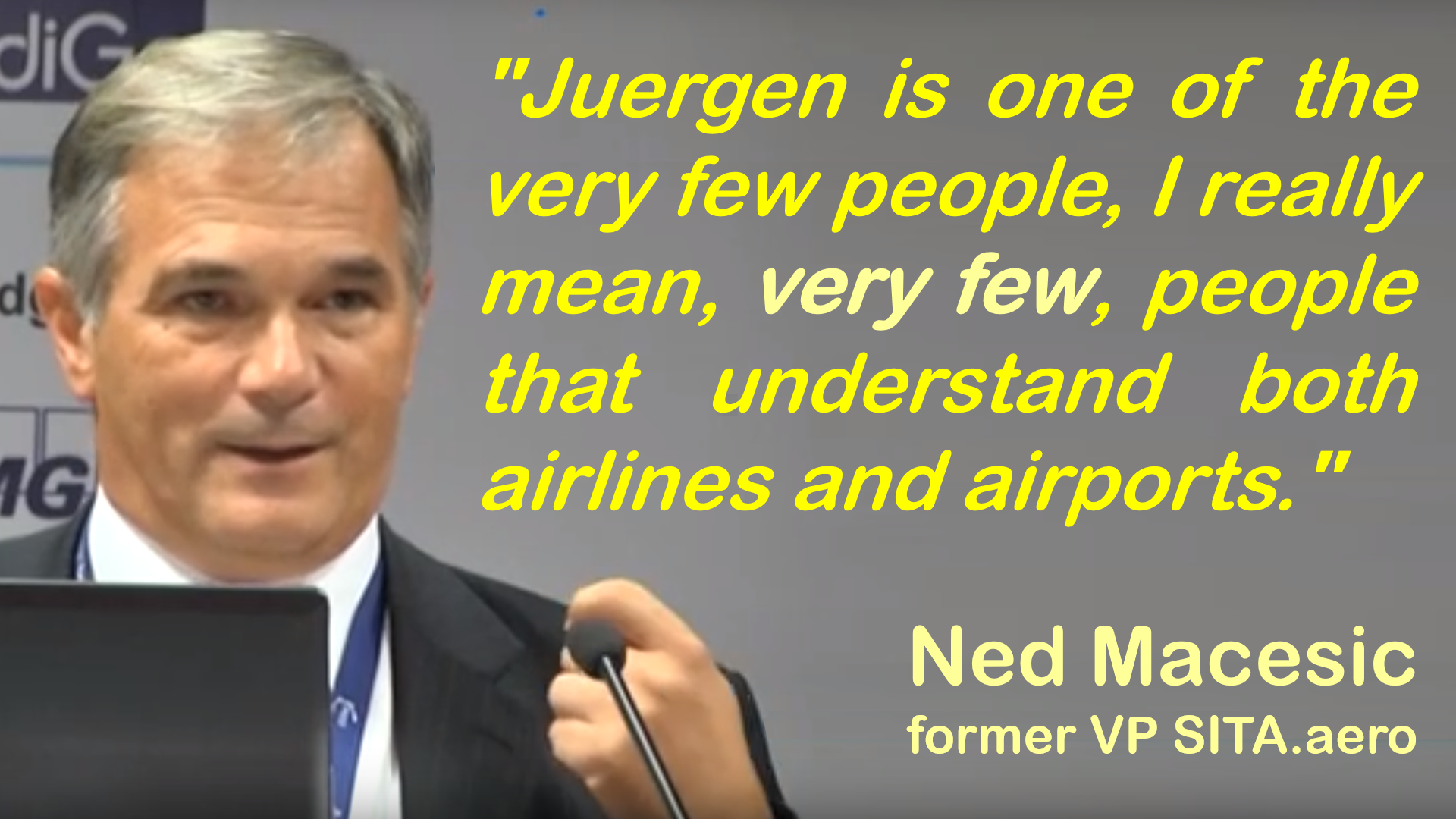
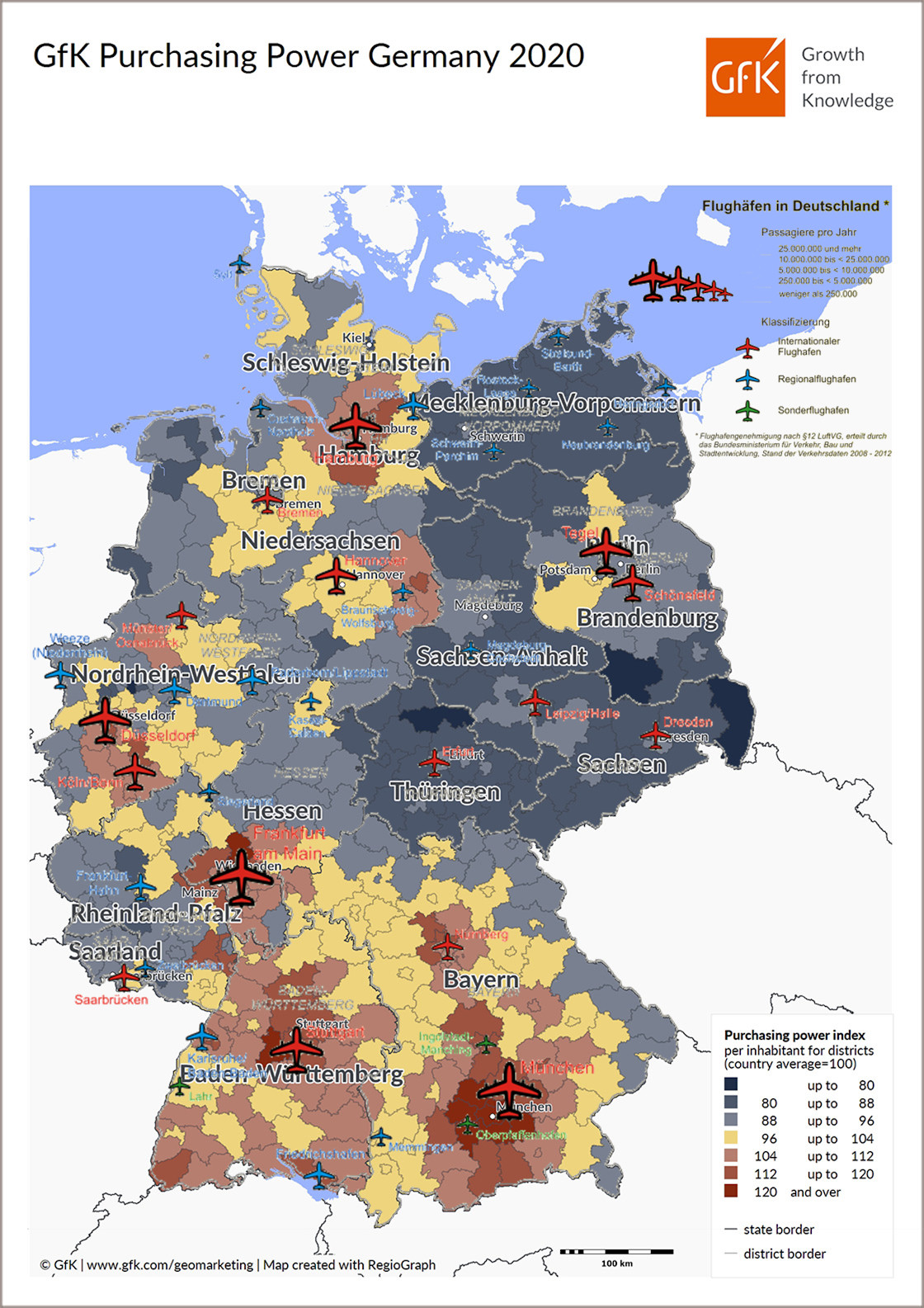 You all know my graphic merging the GFK purchasing power map with the Wikipedia map of airports that I use to visualize the relation between the both.
You all know my graphic merging the GFK purchasing power map with the Wikipedia map of airports that I use to visualize the relation between the both.
Now my friend Ged had put together some numbers, simplifying but following mostly what I used myself in discussions with tourism offices, chamber of commerce, politicos and the other stakeholders that in Germany frequently fight against their airports. Those stakeholders keep failing to understand the commercial impact of “their airports”. In Germany, it’s “airport bashing”. Aircraft noise being an enemy. Transportation statistics on environmental issues beautified to condemn the airlines, I just wrote about the #flygskam reality check.
I have some improvements, but maybe you want to see the info about Ged’s presentation first?
https://simpleflying.com/new-airline-routes-are-worth-huge-amounts-to-destinations/
There are some shortcomings that from experience I do address when talking to the local stakeholders beyond airports. But most politicians I found to prefer airport bashing to understanding. And most airports (not all, there is a slow change) work alone on the route development process. Stakeholders like chambers of commerce, tourism boards, politicians or local media focusing on “other things”. And my original use case was Erfurt with Cirrus Airlines, when I tried to attract KLM to Amsterdam with 70-seat aircraft.
 So let me quickly adjust Ged’s numbers.
So let me quickly adjust Ged’s numbers.
First of all, I prefer frequency over size, so I think we should talk about i.e. a route with 100 seats. Instead of a trice weekly that fails to attract business travelers and suffers such from a higher seasonality, I’d look in turn at a daily service. So let’s keep to the example of an Amsterdam-service with KLM. As operated by KLM will also get you the more attractive ticket prices they can offer.
So over the year, a “daily service” accounts to six weekly flights or about 330 round trips. That accounts (at 100 seats) to 330 days x 1 flight/day x 100 seats x2 (return trip) = 66000 seats. Or slightly more than Ged’s assumption of 29,640 outbound seats we use for typical statistics, we have 33,000. Slightly more, but triggering commercial passengers helps to fill the plane and get some improved ticket revenue.
Talking about 90% load factor – and I agree with Ged, that is minimum what you better plan for nowadays, we need to sell 29,700 seats. For easier calculation, let’s say we must sell 30,000 seats.
 Now comes Ged’s mistake, a rather common one, the “inside-out” look.
Now comes Ged’s mistake, a rather common one, the “inside-out” look.
Passengers never travel only one direction on a plane, ideally they originate on both sides. Different on summer charter flights, I know. But we talk scheduled and low cost services here. So depending on the destination, let’s take the simple equal distribution of in- and outbound travelers. So we talk about 15,000 travelers we target “inbound”.
Next I agree, € 250 total average spend per day for a four day trip is reasonable. But again, I’d adjust slightly here.
Not all travelers go to hotels, there usually is a valuable VFR traffic, visiting friends and relatives. So I’d use only a lower, more conservative €500 for trip spending.
But then Ged fails to use an important multiplier. EU (European Union) usually uses the factor 2.5 (sometimes 3) on the commercial value on any € “spent”. So for any passenger, we talk about 500€ multiplied by 2.5 = 1,250 €. At 15,000 travelers we talk about roughly 19 million € spending by all travelers.
What must be emphasized is the fact that the airline route will also trigger commercial relations with a positive impact to the commerce taxes for the regions as well as the attractivity. Especially on regional airports with such a connection, it will create new jobs, countering the rural exodus so many secondary regions suffer. That is, why the local chamber of commerce (and tourism) have such an impact. If tourism can fill more seats incoming than outgoing, the result becomes even more favorable. A 60/40 in-/outbound results in 3,000 more passengers adding on the incoming value of the flight or 3,750,000 €, totaling the effect to € 22,8 million. Full flights will result in increased frequency or larger airplanes.
If you focus on “holiday flights”, i.e. from an airport like Erfurt-Weimar to the Mediterranean

But given all that, the regions – as mentioned – fail to understand the impact to their commerce. Nor do they understand the financial risk an airline takes, calculating with “competitive” ticket prices they must fill the plane year-in/year-out. If the wonderful biased statistics by the airport marketing fail to materialize the passengers, if the airline looses 10% of the planned revenue, we can quickly talk that many or more million Euros being burned. You may be able to understand why an 80% discount on the “landing fees” are nothing more but an expected risk the airport takes. The brunt of the risk is with the airline.
That said, I remind my readers I am no fan of long-term “airline subsidies”. There are “PSO”-routes, called public service obligation. I would expect the (political) stakeholders of any regional airport to be well advised to fund a PSO-route to one of the big global hubs, but not by “any airline”, but by the hub-carrier. Reminder: German airport association ADV published that most passengers connect online (same airline) or within the airline alliances, there is only negligible numbers of passengers connecting “interline” (between unrelated airlines). Which in my opinion is a result of biased marketing, but it’s like it is now.
But generally, a route shall be set to the right sized aircraft, an attractive frequency and a strong point-to-point demand. Then there can be subsidies, better a real “risk sharing” to establish the route. If the airport/region believes in their own numbers and expectations, they should be willing to guarantee the break even load factor and revenue to the airline. Right? And like any business venture, there must be clear milestones – and an exit scenario if the expectations don’t match the real demand.
 Which triggers the other issue. At the ISHKA Investing in Aviation Finance conference we discussed reasons for airline failures. One very common reason is the fact that airline managers don’t calculate according to their own cost base, but try to compete with ticket prices of their competitors. Not just the real ones, also the implied ones. Trying to fly low cost ignoring their different and higher own cost base. Negotiating new flight services, airports but especially the political stakeholders make it worse by “expecting” unrealistic low cost of operation. They demand that tickets must be cheap. If they, like in Germany, add taxes and make flying more expensive, they shoot their own foot.
Which triggers the other issue. At the ISHKA Investing in Aviation Finance conference we discussed reasons for airline failures. One very common reason is the fact that airline managers don’t calculate according to their own cost base, but try to compete with ticket prices of their competitors. Not just the real ones, also the implied ones. Trying to fly low cost ignoring their different and higher own cost base. Negotiating new flight services, airports but especially the political stakeholders make it worse by “expecting” unrealistic low cost of operation. They demand that tickets must be cheap. If they, like in Germany, add taxes and make flying more expensive, they shoot their own foot.
The financial impact on air travel is a two-sided coin. There is a major impact to commerce and regional income, especially on the incoming travel. But if you focus only on holiday charter flights without incoming, you deprive your region of an important commercial multiplier. In fact, I question your business case. And yes that goes to you Erfurt-Weimar, my prime, sad example.
On the other side, airlines are commercial companies. No airline can keep flying if load and revenue don’t justify.
Food for Thought
Comments welcome!


This week, I received three calls asking me about some new tech. Eventually, all three questions boiled down to one thing: Cloud computing. Food for Thought. I started a blog to address it, when I found I addressed this two years ago in Cloud vs. Security. And the Internet of Things.
Then I got some input about conferences where speakers promoted the need for exchanging data. An issue I addressed as “Open Data” in the same article two years ago.
Same topics obviously resurfacing, but nothing new? So here’s an “update”.
 Recent Airline IT Failures
Recent Airline IT FailuresJust to mention recent developments, the first needing mentioning: The latest large IT outages causing thousands of flights to be cancelled were attributed to failures of minor cloud systems, cascading into disaster causing the aviation IT systems to fail, leaving thousands of passengers stranded – not good for reputation.
The CIO of two airlines admitted that their main headaches result from such “SaaS” (Software as a Service), being not controlled by their company. But by some external IT experts who often do not understand the real-world impact of their “ideas”. And lousy interfaces of such “solutions”. Cheap to buy, expensive to manage.
 Another development is the “voice assistants” at home. To give the example of Alexa. As you know, my beloved daughter is called Alexsandra, so if I would use such device it would listen in, as soon as someone addresses her. Also the Echo Dot alternatives of “Amazon”, “Echo” and “Computer” are not much safer. And meanwhile, press reported how extensive Google, Amazon and others use “their” devices not to just provide a service, but filing your commands and conversations for analysis. An intrusion to my privacy causing me to caution and not buying into them.
Another development is the “voice assistants” at home. To give the example of Alexa. As you know, my beloved daughter is called Alexsandra, so if I would use such device it would listen in, as soon as someone addresses her. Also the Echo Dot alternatives of “Amazon”, “Echo” and “Computer” are not much safer. And meanwhile, press reported how extensive Google, Amazon and others use “their” devices not to just provide a service, but filing your commands and conversations for analysis. An intrusion to my privacy causing me to caution and not buying into them.
Aside, my Android phone has been set up to not react to voice activation, but I found it to react and switch on voice recognition without my doing. I did like Siri and now Android’s voice recognition to send messages from the car to home. But not on voice activation. I do want some privacy left.
Don’t get me wrong. I love Voice Assistants. My friend Alex developed the first Internet Assistants at his company VirtuOz, later sold to Nuance. His next project WIT.ai was about voice recognition and later acquired by Facebook, the basis for their solutions. What I am concerned about is simply the privacy invasion, if those tools file away my communication for unspecified further use. I may talk about confidential issues.
To make it worse, there have been, are and will be attempts – and successes – by governments to access i.e. Alexa and her companions. Privacy? I’m not a criminal, but no, I do quite some thinks to secure my private life. 1984 anyone?
Aside having my “own” Internetserver, I use Nextcloud for two years now (thanks Jens!). To use it properly, like Dropbox, Google, Apple or Microsoft, you need a client program that integrates into your file manager (i.e. the Microsoft Explorer). I neither trust Dropbox not the others (except on encrypted storage), we’ve all learned from Edward Snowden.
In the end, it is a trust thing. I trust my friend who maintains “my server”. Totally. My family trusts me that I have other things to do than sneaking into their mailboxes or files they have in their own Nextcloud on my server.

 Meanwhile and especially with the current president who seems to lack the moral values required for someone elected into such power, the “United States” in my opinion turn from friend to foe for Europe. Or at least someone who doesn’t care about our (common) well-being. Doing the wrong things for the wrong reason. Get me right. As everywhere there are good and bad people. Listen to Billy Joel’s Leningrad if you’re thinking different. And the Merkel-government is not any good either. From shining example for development and engineering, “Made in Germany”, we deteriorated into a “back midfield” in comparison to other states and sell out pioneering developments to China and America. And our corrupt government (it’s called “Lobbying”) strangles personal freedom with laws under the umbrella of “fighting terror”. But as I said about the U.S. – it is good to have a global sheriff, but I’m afraid what happens if the government changes and becomes “bad”. Do I entrust atomic warfare to someone like Trump? In honesty, I have more faith in Putin in that aspect than the lunatic in the White House.
Meanwhile and especially with the current president who seems to lack the moral values required for someone elected into such power, the “United States” in my opinion turn from friend to foe for Europe. Or at least someone who doesn’t care about our (common) well-being. Doing the wrong things for the wrong reason. Get me right. As everywhere there are good and bad people. Listen to Billy Joel’s Leningrad if you’re thinking different. And the Merkel-government is not any good either. From shining example for development and engineering, “Made in Germany”, we deteriorated into a “back midfield” in comparison to other states and sell out pioneering developments to China and America. And our corrupt government (it’s called “Lobbying”) strangles personal freedom with laws under the umbrella of “fighting terror”. But as I said about the U.S. – it is good to have a global sheriff, but I’m afraid what happens if the government changes and becomes “bad”. Do I entrust atomic warfare to someone like Trump? In honesty, I have more faith in Putin in that aspect than the lunatic in the White House.
So with governments applying the thumb screws on the IT industry, how save is your data in the cloud?
Big Brother watches us and all governments (including the German) undermine privacy and invest heavily into technologies and change the laws to enable further invasion of privacy and inside your own four walls. You trade in convenience with privacy.
The DHS in it’s early days seized the computer of the top-level representative of a large European aircraft maker. In direct competition to date with that U.S. aircraft maker. When the manager denied giving the password, he ran into major trouble, missing his connecting flight. Not given a written confirmation that the content of his laptop wouldn’t make it to the U.S. competitor… That was “friendly” America – not Russia, where I never experienced “security issues”. My computer is secured, my data is not on the computer, only what I need enroute and that’s encrypted on the drive.
My personal summary is what my friends at ASRA called me paranoid upon my presentation 2007 (a dozen years ago). I am not, but careful. I am a public persona on the Internet. But thinking about governments hacking, falsifying and abusing data, who do I trust my data to? Think about the discussions about Huawei and 5G, do we trust them? If we would use encrypted data communication by default, Tor Browser, SSL, encrypted mails, Huawei would be a no-issue. But I still know too many companies first hand, not using contemporary anti-virus software on their mail servers and mail accounts. Trust Microsoft Onecloud? Apple, Dropbox? No, not really. Trust my own cloud? No, any system can be hacked. Can I protect myself 100%? No. But I can make it more difficult.
 Commercially, I believe it a step back to use SaaS, which is another word for “cloud computing”. If you use SaaS, better be prepared and test what happens if the “outsider” provides corrupted data, what happens in case of a link failure – and recovery. Using different computer systems, often lousy connected increases the dependency on “others”. I can’t tell you, how often I was fighting with SaaS-companies to get access to my own data. Or how they imply that “their” data is always superior to anyone else. A-CDM anyone? CRM tools anyone? I am sure you can sing that tune along…
Commercially, I believe it a step back to use SaaS, which is another word for “cloud computing”. If you use SaaS, better be prepared and test what happens if the “outsider” provides corrupted data, what happens in case of a link failure – and recovery. Using different computer systems, often lousy connected increases the dependency on “others”. I can’t tell you, how often I was fighting with SaaS-companies to get access to my own data. Or how they imply that “their” data is always superior to anyone else. A-CDM anyone? CRM tools anyone? I am sure you can sing that tune along…
SaaS, Cloud is like a consultant. You use them in two situations. To cover something to complex and specialized needed for a short time that it does not make sense to develop your own know-how on it. Or to train your own to become better on such. Other issues can be to get an outside view – or to outsource blame or the risk of such. In all other cases, I strongly recommend to hire an employee. Hire software companies to provide a solution that fits your own “cloud”. Your IT environment. Use cloud to back up data into encrypted data vaults. But make sure, you have complete access to your information and raw data.
And don’t believe the SaaS-sales people when they tell you that you have all the access to your data. It’s their interest to fix you to their “environment”. And never let you off their hook. And “real time data integration” with other systems is in reality very low on their priority list. Again that question by SITA about the “source of the most common truth”. If data is in conflict most those SaaS, they assume that “naturally” they are right. And ATC, airline, ground handler, airport, government or whoever comes up with conflicting data is wrong…
Food for Thought
Comments welcome!
Side note: I use a licensed Dilbert comic – for private and single use in a blog they charge $35 plus $10 “processing fee”, totaling to $45. I find that rather expensive and counterproductive, sorry that I don’t promote them…


As many of you know, from March to June, I attended a full-time qualification in Online-P.R. (public relations), online-marketing, search-engine optimization (SEO), marketing (SEM) and analysis (SEA) and online advertising. Sure this was contemporary in an online class room I had to log-in at prescheduled times.
The motivation to do that was an implied lack of online experience, a missing understanding of the intricacies (details) what makes online different from the classic offline. That this was a bold misperception on my own can be seen in the results. All three exams I finished with 100% (grade 1.0). I was mostly unchallenged, contributed to the topics, explained and even on several occasions proved the tutors wrong.
What surprised me most is the fact that there is an industry that claims that this is all new and you need all new experts and agencies doing it for you. But if you properly learned your business, it is nothing new at all. The rules are all the same! In addition, I found there is simply an industry implying and claiming value where there is none. We talked and learned a lot about analysis, but you can analyse yourself to death. To do an analysis of one simple “advertising” or “website optimization” for the search engines took hours. Aside the need for external (mostly paid) services.
I still believe, the tutor on search engine optimization and analysis has been paid to use certain tools. There is no alternative to Google Analytics? Feed the big monster your internal data? By adding Google Analytics, Google learns about “hidden pages” and if they are not password protected, Google can (and does) parse them. Yes, I know many cases where Google had access to pages that were not linked elsewhere. Funny as that is, I have my browser to only accept cookies from the website I visit and not from “third party websites” (like Google Analytics). A not uncommon setting That results in an offset with Google, counting me again and again and again.
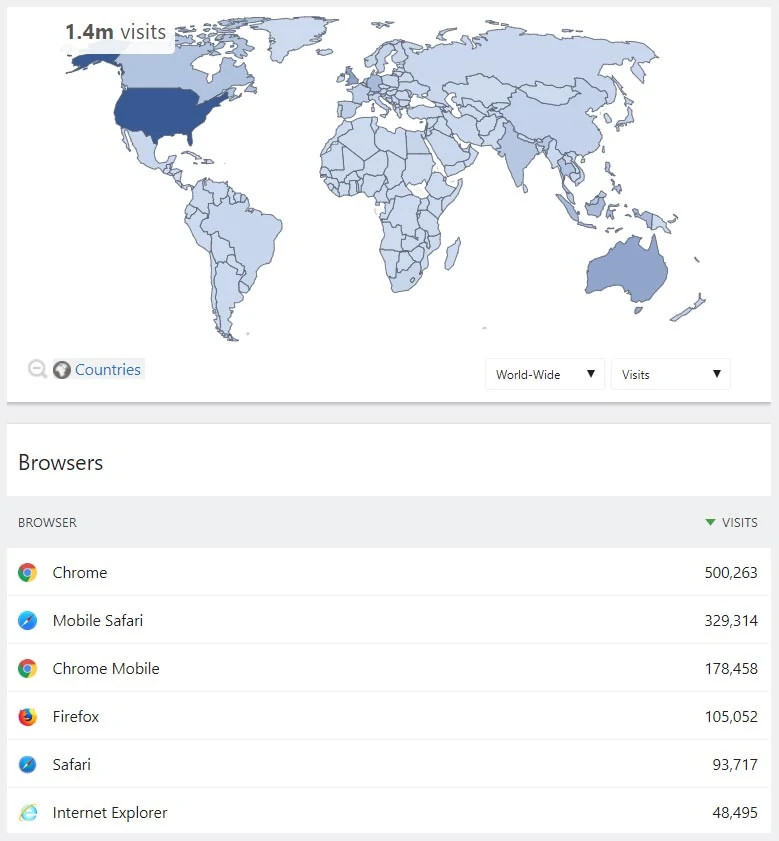 Instead of Google Analytics, I prefer Matomo on Premise analytics. They also offer “in the cloud” (on Matomo servers), but that results in the same shortcomings as Google and comes with a price tag. So if you want to become independent of releasing sensitive information to Google, go to Matomo on Premise. If you use WordPress, they are in the process (Beta testing phase) for Matomo for WordPress, which I am about to test on this blog.
Instead of Google Analytics, I prefer Matomo on Premise analytics. They also offer “in the cloud” (on Matomo servers), but that results in the same shortcomings as Google and comes with a price tag. So if you want to become independent of releasing sensitive information to Google, go to Matomo on Premise. If you use WordPress, they are in the process (Beta testing phase) for Matomo for WordPress, which I am about to test on this blog.
As Matomo runs on your own server, the cookies work properly an the analysis are as good – sometimes better, sometimes worse, just like the difference between Apple iOS and Android or Open Office vs. Microsoft.
 If you have subscribed to the RSS or follow my posts on LinkedIn, you may recall my note on the June-post, which I “optimized” for Search Engines (aka. SEO). And analysed. Funny as that is, the website did not appear much better in the real world search engines. Slightly maybe. But I got quite some feedback from my friends reading this, that I shall go back to write “my style”.
If you have subscribed to the RSS or follow my posts on LinkedIn, you may recall my note on the June-post, which I “optimized” for Search Engines (aka. SEO). And analysed. Funny as that is, the website did not appear much better in the real world search engines. Slightly maybe. But I got quite some feedback from my friends reading this, that I shall go back to write “my style”.
I somewhat expected that, but was quite shocked to the extend of the quality (or lack of it) of search engine analysis. While we looked at real websites, analyzing using several different services (including Google Analytics), we could create success by the selection of analysis results. It was another fantastic example on the proverb usually (incorrectly) attributed to Winston Churchill: “The only statistics you can trust are the once you falsified yourself”. Presented then to managers without the experience, it all looks shiny and good, but is simply Hokus Pokus.

How do you qualify “Reach”? By the visitors? See above on Google Analytics relying on IP and Cookie – a cookie they never get in my case. At home, I have a new IP every 24 hours (thanks to my internet provider). Talking to Marketing Managers, I keep getting the confirmation of what I learned in the early days of Internet. In the GDS and first online tools we talked about the “Look to Book Ratio”.
In the good old GDS era before Internet, a travel agent looked up an availability (for a flight, hotel, rental car, etc.). Talking to the customer, the booking was confirmed, a “look to book ration of 5 I believe to remember. At the dawn of online travel booking, the processes got instant. First the availability. Then a booking. But to book, the availability was redone. And that is just the tip of the iceberg of the complexities we (I) resolved developing the first online booking tool in Europe. The look to book ratio exploded. Even adding sophisticated caching (reuse of data), the systems had to “evolve” to manage the increase in processing power needed.
But how does that compute with “Reach”? Reach are generally unique visits. Some SEA-experts use simple visits – every time someone visits or revisits a website or page. Even with the more accurate unique visits, a visit does not tell you anything on any revenue being generated. Except if you use banner ads and get paid by vistor. Aside visits, there is clicks. Most advertisements are “per click”, at least that brings a visitor to the targeted website. But while P.R. and Marketing are not Sales, they are not an end to themselves but must result in promoting the product and services and generate revenue. I know many P.R. and Marketing Managers (and their bosses) not understanding the difference.
If you believe “Reach” is your goal and you value “Reach” above all else, I hope that that reach results in revenue. And you can have the best reach with no revenue. So I call reach a fairy tale. In the end, it is all about revenue. For sales, not only the price counts, but also brand, reputation and being in the mind of the customer. But it all boils down to being where the customer is when the customer needs your products or services, to be in the mind and to come up.

What are your KPIs, your key performance indicators in Marketing and P.R. qualifying success?
As a Chief Marketing Officer of a now bankrupt airline recently told me: “In Marketing KPIs are a smoke wall. Do you truly believe all those haters visiting your website are lovers? How can you distinguish visitors?”
They had all followers, all fans, all visitors – but not enough sales. Marketing is long term, make sure you’re seen, together with P.R. looking after your reputation, that it is good, but in the end, if they don’t steer sales and help to improve revenue, you can shunt their KPIs. Even “reputation” and “visibility” are only means to generate sales.
If you reach the wrong people, they don’t mean anything. So what’s your KPIs and are they clear? “The good ones in the little pot, the bad ones for your little crop”.
And our tutor showed us how to tamper the statistical outcome in your favor by selecting what confirms the wanted result. I call that cheating your bosses…

Talk to me if you are interested to discuss this. It’s a complex topic and can (and does) fill books. But to boil it down, the rules of engagement are the same on- or offline.
KPIs were in use long before Internet and mostly used as misleading as I see those agencies use them. And there is a very strong tendency by those agencies to justify their overvalued work as valuable. So they try to tamper the KPIs and the statistics in their favor.
Who do you write for? What is your goal? How can you reach the customer, spread your brand message, stimulate sales and reputation? If you look at it “academically”, you can spend your time analyzing your efforts to death and beautify the results to your liking or the one of your superiors.
Or you get things done, use two or three tools for analysis and make sure you understand KPIs and use them meaningful.
Sales will hardly work if you have no marketing, nor P.R., advertising and branding. But don’t overdo it. And don’t split them up, they got to interact and work together for a common goal. Revenue. Income.
Food for Thought
comments welcome!

All the industry discusses #flygskam (flyshame), but even given sound studies disqualifying the topic, our own lobbyists fail to organize a concerted response to the case. Let’s have a reality check…
There were some reports recently on German television and in the media. German “Welt” (TV + newspaper) reported “Green (party) Demands: Climate Sin Domestic Flight? Abolition Hardly Saves CO2“.
The use of ships to travel from Scandinavia or Britain to Europe or crossing the Mediterranean I think I don’t need to remind of the extreme emissions of cruise and other ships?
 But there was another article even more to the point: “Where there is a will there is not always a train“. But there are some issues that are unrealistic. The numbers of German Rail are biased and greenwashed. They claim to use only “Green Power”. But in fact, published by the German Federal Environmental Agency, their power comes from the public grid and no matter what “deals” they do, it is grid power. And on the grid, in 2018 only 16.6% has been “Green” (Source). The energy industry accounts for 85% of all Greenhouse Gases of which 98% CO2, the remainder being mostly Methane (CH4) and nitrous oxide (N2O) (Source).
But there was another article even more to the point: “Where there is a will there is not always a train“. But there are some issues that are unrealistic. The numbers of German Rail are biased and greenwashed. They claim to use only “Green Power”. But in fact, published by the German Federal Environmental Agency, their power comes from the public grid and no matter what “deals” they do, it is grid power. And on the grid, in 2018 only 16.6% has been “Green” (Source). The energy industry accounts for 85% of all Greenhouse Gases of which 98% CO2, the remainder being mostly Methane (CH4) and nitrous oxide (N2O) (Source).

But what also needs to be taken into account is the emission per passenger. Be it rail, in average used 22% only, whereas those passengers are mostly commuters, filling up the trains above their limits in the rush hours. That is not only true for the commuter but also the long-haul routes. This year, the long-haul trains’ punctuality was only 69.8%. For 2018, German Rail reported 16 routes operating above capacity – passengers finding no seat being just another annoyance, half of the delays are a result of those overused routes. That 20% of the trains are in (often unscheduled) repairs, toilets and air condition known to be out of service just being others. Just a reminder, the average load factor of flights according to IATA is about 85%.
 Given the devastating destruction of the natural environment in Lithium mining, I do not understand that politicians push forward battery-based e-Mobility. Using fuel-cell technology we can use the existing gas stations infrastructure. Refueling takes only about five minutes! And given a broad use will lower the prices and make the technology available on smaller cars too. They can even power scooters, so don’t tell me it doesn’t work for a compact car!
Given the devastating destruction of the natural environment in Lithium mining, I do not understand that politicians push forward battery-based e-Mobility. Using fuel-cell technology we can use the existing gas stations infrastructure. Refueling takes only about five minutes! And given a broad use will lower the prices and make the technology available on smaller cars too. They can even power scooters, so don’t tell me it doesn’t work for a compact car!
Instead they promote an ecologically catastrophic technology with a completely missing loading infrastructure…?
More information I addressed in September 2021 in the post The e-Mobility Lie. Inspired by a documentary by German ZDF’s Planet(e): Mythos Elektroauto (naturally German). [Added Oct.21]
 There is an important advantage of air travel to both rail and road that is frequently not addressed. The issue of ground sealing!
There is an important advantage of air travel to both rail and road that is frequently not addressed. The issue of ground sealing!
For an airport, about 2,500 x 45m are typically “sealed for the runway, in total about 3,000 by 400 m are required for a regional airport, of which only 25-30% of the ground are “sealed” by infrastructure, 70-75% being grass areas. So we talk about 400,000 m² of an average regional airport being “sealed.
 A highway with four lanes is about 31 m wide with about 24 m being sealed. A 50 km highway such seals about 1.2 million m², so three times as much as a single airport. Highways are known to be an insurmountable obstacle for wildlife.
A highway with four lanes is about 31 m wide with about 24 m being sealed. A 50 km highway such seals about 1.2 million m², so three times as much as a single airport. Highways are known to be an insurmountable obstacle for wildlife.

 Rail
RailFor Rail we talk about a minimum of 12 meters sealed width for 2 tracks, up to 20 meters on high speed train routes and and average of about 15 meters. So on 50 km of rail we talk about 600,000 m² of sealed ground. Before we start talking about the railway stations…
I don’t have the number, not even for Germany, but it might be an interesting comparison for the aviation industry to compare the total ground sealed for highways (not talking about cities) and rail, compared to airports. I think that will be a devastating result for the ground transportation modes.
My hope on rail is that hyperloop we will not seal more ground, but will be established underground.

Yes, I am a big fan of the CO2-tax. If it is used to compensate for bio- or better SynKerosene! So far, all eco-taxes are abused to cover up for growing demands of the policos for their “other agendas”. But did you know that the German air traffic accounts for less than 0.3% of the CO2-emissions in Germany? (Source)
National Geographic last year reported about a development by Canadian Carbon Engineering, using CO2 with hydrogen (H2) to create artificial kerosene (and gasoline). Whereas there are industry sources to provide excessive CO2, hydrogen can be created using solar parks. The resulting bio-kerosene is an independent power storage. As the CO2 from burning that bio-kerosene equals the amount that was used from the environment, it is a completely climate neutral solution. And using solar energy for the electrolysis and the power needed for the processing, there is a power loss, but that is ecologically irrelevant.
But… Why do the media and politicos actively neglect those developments? Why do they go for dirty Lithium?
So what is the reality check for #flygskam (flight shame) vs. the “green rail”? Green rail is a myth, the power consumption not close as “green” as they say. Considering the ground sealing also favors aviation. And should we in aviation invest large scale into bio-kerosene, lowering the prices to competitive cost levels, replacing crude-oil-based fuel… A CO2-tax such might be an enabler for the conversion. If our lobbyists would show balls, which I’m afraid from experience, they don’t have.
But sustainable transport, including air transport is acknowledged as an important factor in the United Nations Sustainable Development Goals to develop regions, counterbalancing inequalities and disparities!

I think it should not be aviation bashing, nor should we greenwash rail, but we should develop a sustainable transport network for everyone. Connect individual transport to rail, hyperloop or flight. It is the mix we need, not enemy stereotypes! And we need funds to support strategic projects selected, not the ones having the biggest lobbies. And “batteries” are no solution but a pest! Lithium mining destroys the planet!
#flyshame is out! Flying is a vital service for a global world. To disqualify it with false facts does not help to make our world a better place.
#railshame is my new buzzword!
Food for Thought!
Comments welcome…